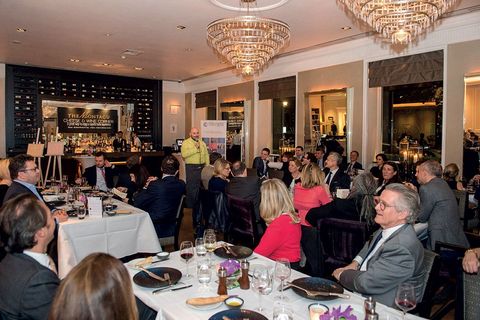Analyses & Studies
Côte d’Azur comes to London

The guests of the latest Dîner des Chefs joined the long list of luminaries to be hosted by the Michelin-starred chef Christian Sinicropi, says INFO’s Sophie Achary
Jane Campion, Robert de Niro and Pedro Almodóvar are just a few of the cinema elite to have enjoyed Chef Christian Sinicropi’s cuisine at The Palme d’Or, the two Michelin-starred restaurant of the Grand Hyatt Hotel in Cannes. Each year, Sinicropi prepares a menu of intricate and delicious dishes inspired by the careers of the Jury of the Cannes Film Festival – all the while staying true to his gastronomic roots in the South of France.
For the 18th edition of the Dîner des Chefs, held at the Hyatt Regency, Sinicropi brought the charm and regional specialities of his Mediterranean kitchen to London. His menu included a pissaladière, an iodised main course with langoustine, caviar and prawn, a chocolate dessert with piedmont hazelnut.
The food was paired with a selection of fine wines from Crus Classés de Graves, represented by Stephen Carrier, and the diner ended with coffee and Martell Cordon Bleu Cognac represented by Laurent Pillet.
In a lively atmosphere, the Chamber’s Managing Director Florence Gomez introduced the Chef by highlighting his exceptional career. Afterward, Sinicropi discussed his influences with the assembled diners.
You are known as a chef for your creativity. Could you describe your cuisine?
It’s a cuisine which combines the five senses. It is superimposed but does not mix. It is culturally focused on its Mediterranean and Latin roots with local produce and recipes.
Another specificity of my cuisine is my use of ceramics since 2006 [Sinicropi creates original plates for his restaurant with his wife Catherine]. I dress my cuisine like a person, depending on its morphology - the recipe and the produce.
Your influences are Mediterranean.
Whenever you travel to a country with a strong gastronomic culture, you come back marked. In France, there are regions with heterogeneous cultures, and our clients come to the restaurant to discover them. I am of Italian descent, but I was born in Cannes. I am French, and I was raised with this culture. I believe that when people come to my restaurant, it is to discover this cuisine. My produce comes from the region. I would describe my cuisine as 100% Mediterranean.
Where did you draw your inspiration for a dinner in London?
My cuisine stayed Mediterranean, but with frivolities such as sardines, paprika. I revisited the pissaladière – which did not look like the classic French south-eastern dish, but did taste like it. The starter was very green, around a radish and its minerals. Visually, it was very simple, but the originality of the tastes was very pronounced.
We were also intrigued by your ‘choco-pigeon tartlet.’
The aim with this dish is to surprise guests. It has the appearance of a chocolate tartlet, but is really a pigeon-thigh crumble, the meat preserved for 48-hours. There is no chocolate, the sauce is thickened with blood. I had the occasion to make a vegetarian version of this tartlet, as well as a choco-sardine version.
Your new cookbook is called ‘New Classics’. What is the secret to creating new dishes with lasting impact?
« I dress my cuisine like a person, depending on its morphology - the recipe and the produce. »
I used one British product: langoustines. They were served with a crustacean broth and vegetables. Langoustine is a very reliable product, which is delivered to us alive. As we are sensitive to sustainability issues, we set up a tank to avoid waste.
This article was originally published in INFO magazine, January/February 2018